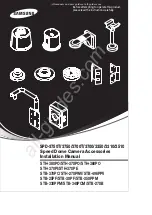
C.E.S. Model SDI-50 Manual, General Description
transmitter, then move JMP7 on the interconnect circuit board (near
the PTT relay K2), to position A.
4.1.4 TB1-20 LOGIC PTT
Logic PTT is similar to the relay PTT output except that it only
provides a ground to key the transmitter. Using this PTT control will
free the auxiliary relay contacts for user defined custom
applications.
4.1.5 TB1-14 TRANSMIT AUDIO
This connection supplies the transmitter with processed audio from the
telephone line. This connection shouid be made to the transmitter
microphone voice audio input. The TRANSMIT AUDIO is normally shipped
from the factory for a low impedance audio output. If the voice audio
input to your transmitter is high impedance, then remove JMP5 on the
interconnect circuit board to convert the TRANSMIT AUDIO output to
high impedance, and to match your transmitter impedance more closely.
This will permit the level adjustment to be less sensitivo. Be sure
to use shielded cable.
4.1.6 TB1-4_______AUXILIARY TRANSMIT AUDIO IN
This input is an auxiliary transmit audio input which can be used for
special applications when more then one audio source is needed or
used. There are no controls or level adjustments associated with this
input.
4.1.7 TBl-9,10 and 21 AUXILIARY RELAY CONTACTS
TB1-21 Relay Common
TB1-10 Relay Normally Closed (NC)
TB1-9 Relay Normally Open (NO)
These spare relay contacts are active when the interconnect keys the
PTT line or follows the phone line connect relay. The contact
arrangement can be used for switching logic signals, or audio signals.
The most common use for these contacts is to allow the interconnect to
switch between "Interconnect Transmit Audio" and "Repeat Transmit
Audio" that is derived from a repeater panel connected in the system.
JMP8
Auxiliary Relay Control________________________________Position
Auxiliary Relay follows the Connect Relay B/C
Auxiliary Relay follows the PTT signal B/A
4.1.8 TB1-3 CTCSS-DCS DECODE INPUT
This connection is optional, and can be left unconnected if not used.
The purpose of the CTCSS-DCS DECODE INPUT is to inhibit the
interconnect unless the proper CTCSS tone or Digital Coded Sgueich
(DCS) is present. Typically, this input is connected to an external
CTCSS decoder which, upon decode, will cause the CTCSS DECODE INPUT to
change state,
Page # 8













































